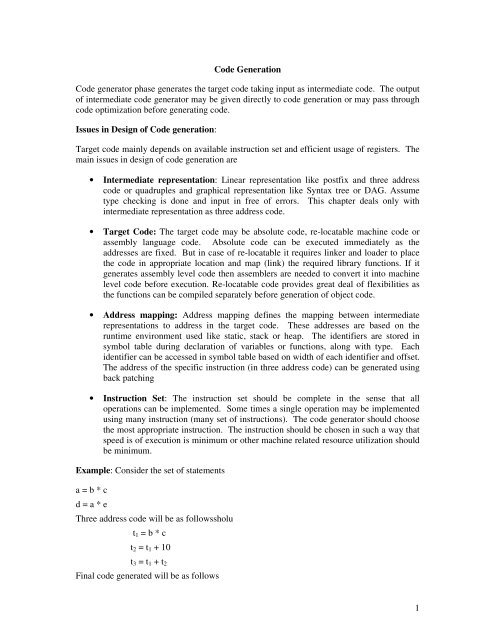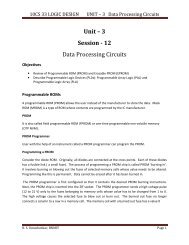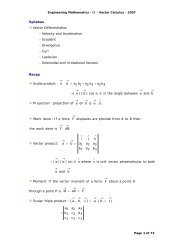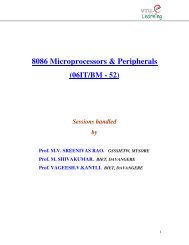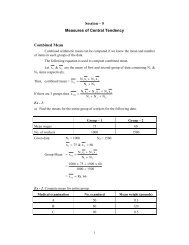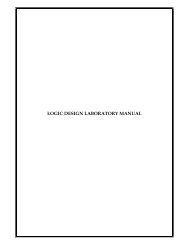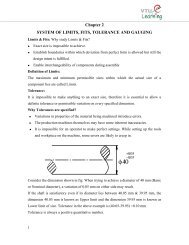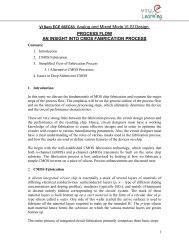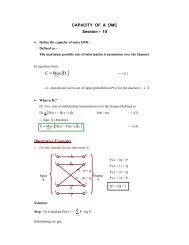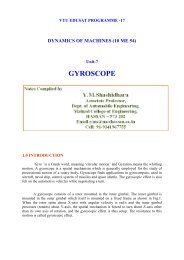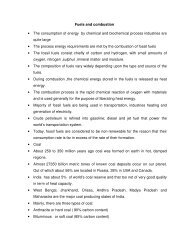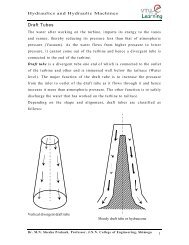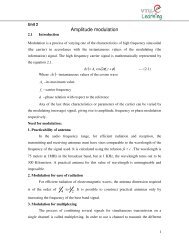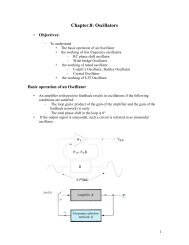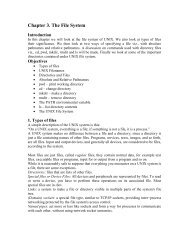1 Code Generation Code generator phase ... - VTU e-Learning
1 Code Generation Code generator phase ... - VTU e-Learning
1 Code Generation Code generator phase ... - VTU e-Learning
You also want an ePaper? Increase the reach of your titles
YUMPU automatically turns print PDFs into web optimized ePapers that Google loves.
<strong>Code</strong> <strong>Generation</strong><br />
<strong>Code</strong> <strong>generator</strong> <strong>phase</strong> generates the target code taking input as intermediate code. The output<br />
of intermediate code <strong>generator</strong> may be given directly to code generation or may pass through<br />
code optimization before generating code.<br />
Issues in Design of <strong>Code</strong> generation:<br />
Target code mainly depends on available instruction set and efficient usage of registers. The<br />
main issues in design of code generation are<br />
• Intermediate representation: Linear representation like postfix and three address<br />
code or quadruples and graphical representation like Syntax tree or DAG. Assume<br />
type checking is done and input in free of errors. This chapter deals only with<br />
intermediate representation as three address code.<br />
• Target <strong>Code</strong>: The target code may be absolute code, re-locatable machine code or<br />
assembly language code. Absolute code can be executed immediately as the<br />
addresses are fixed. But in case of re-locatable it requires linker and loader to place<br />
the code in appropriate location and map (link) the required library functions. If it<br />
generates assembly level code then assemblers are needed to convert it into machine<br />
level code before execution. Re-locatable code provides great deal of flexibilities as<br />
the functions can be compiled separately before generation of object code.<br />
• Address mapping: Address mapping defines the mapping between intermediate<br />
representations to address in the target code. These addresses are based on the<br />
runtime environment used like static, stack or heap. The identifiers are stored in<br />
symbol table during declaration of variables or functions, along with type. Each<br />
identifier can be accessed in symbol table based on width of each identifier and offset.<br />
The address of the specific instruction (in three address code) can be generated using<br />
back patching<br />
• Instruction Set: The instruction set should be complete in the sense that all<br />
operations can be implemented. Some times a single operation may be implemented<br />
using many instruction (many set of instructions). The code <strong>generator</strong> should choose<br />
the most appropriate instruction. The instruction should be chosen in such a way that<br />
speed is of execution is minimum or other machine related resource utilization should<br />
be minimum.<br />
Example: Consider the set of statements<br />
a = b * c<br />
d = a * e<br />
Three address code will be as followssholu<br />
t1 = b * c<br />
t2 = t1 + 10<br />
t3 = t1 + t2<br />
Final code generated will be as follows<br />
1
MOV b, R0 / load b to register Ro,<br />
MUL C, R0<br />
MOV.R0, a Mov a to Ro and moving Ro to a can be eliminated<br />
MOV a, R0<br />
MUL e, R0<br />
MOV R0, d<br />
Redundant instruction should be eliminated.<br />
Replace n instruction by single instruction<br />
x = x + 1<br />
MOV x, R0<br />
ADD 1, R0 ⇒ INC x<br />
MOV R0. x<br />
Register allocation: If the operands are in register the execution is faster hence the set of<br />
variables whose values are required at a point in the program are to be retained in the<br />
registers.<br />
Familiarities with the target machine and its instruction set are a pre-requisite for designing a<br />
good code <strong>generator</strong>.<br />
Target Machine: Consider a hypothetical byte addressable machine as target machine. It<br />
has n general purpose register R1, R2 ------- Rn. The machine instructions are two address<br />
instructions of the form<br />
op-code source address destination address<br />
Example:<br />
MOV R0, R1<br />
ADD R1, R2<br />
Target Machine supports for the following addressing modes<br />
a. Absolute addressing mode<br />
Example: MOV R0, M where M is the address of memory location of one of the<br />
operands. MOV R0, M moves the contents of register R0 to memory location M.<br />
b. Register addressing mode where both the operands are in register.<br />
Example: ADD R0, R1<br />
c. Immediate addressing mode – The operand value appears in the instruction.<br />
Example: ADD # 1, R0<br />
2
d. Index addressing mode- this is of the form C(R) where the address of operand is at the<br />
location C +Contents(R)<br />
Example: MOV 4(R0), M the operand is located at address = contents<br />
(4+contents(R0))<br />
Cost of instruction is defined as cost of execution plus the number of memory access.<br />
Example:<br />
MOV R0, R1, the cost = 1 as there are no memory access.<br />
Where as MOV R0, M cost = 2.<br />
Register and address descriptor<br />
Register descriptor gives the details of which values are stored in which registers and the list<br />
of registers which are free.<br />
Address descriptor gives the location of the current value can be in register, memory location<br />
or stack based on runtime environment.<br />
<strong>Code</strong> generation algorithm<br />
Consider the simple three address code for which the target code to be generated.<br />
Example: a = b op c<br />
i.Consult the address descriptor for ‘b’ to find out whether b is in register or memory<br />
location. If b is in memory location, generate code.<br />
a. MOV b, Ri where Ri is one of the free register as per register descriptors.<br />
Update address descriptor of b and register descriptor for free registers.<br />
ii.Generate code for OP C, where C can be in memory location or in register.<br />
iii.Store result ‘a’ in location L. L can be memory location M or register R, based on<br />
availability of free register and further usage of ‘a’. Update register descriptor and<br />
address descriptor for ‘a’ accordingly.<br />
Example: x = y + z<br />
Check for location of y,<br />
Case 1: If y is in register R0 and z may be in register or memory. The instructions will be<br />
ADD z, R0<br />
MOV R0, x<br />
In this case the result x has to be stored in memory location x.<br />
Case2: If y is in memory, fetch y to register, update address and register descriptor<br />
3
MOV y, R0<br />
ADD z, R0<br />
MOV R0, x<br />
Example:<br />
P = (x – y) + ( x – z) + ( x – z)<br />
t1 = x – y<br />
t2 = x – z<br />
t3 = t1 + t2<br />
t4 = t3 + t2<br />
Three address code<br />
3 addr M/c <strong>Code</strong> Cost Reg desc Addr desc<br />
t1 = x – y MOV x , R0 2 R0 has t1 t1 in R0<br />
SUB y , R0 = 2<br />
t2 = x – z MOV x , R1 2 R0 has t1 T in R0<br />
SUB z, 12 2 R1 has t2 U in R1<br />
t3 = t1 + t2 ADD R1 , R0 1 R0 has t3<br />
t4 = t3 + t2<br />
ADD R1, R0<br />
MOV R0, t4<br />
1<br />
2<br />
R1 has t2<br />
Example: Generate code for instruction x = y[i] and x [i]=y<br />
t2 in R1<br />
t3 in R0<br />
R0 has t4 t4 in R0 and<br />
memory<br />
Stmt i in reg Ri i in Memory i in Stack<br />
<strong>Code</strong> Cost <strong>Code</strong> Cost <strong>Code</strong> Cost<br />
x = y [i] MOV y (Ri), R 2 MOV M, R 4 MOV Si (x), R 4<br />
MOV b (R1, R2) MOV y (R), R<br />
x [i] = y MOV y, x (Ri) 3 MOV M, R 5 MOV Si(x),x<br />
MOV y, x (R)<br />
5<br />
<strong>Code</strong> generation for function call<br />
<strong>Code</strong> generation for function code is base on the runtime storage. The runtime storage can by<br />
static allocation or stack allocation. In case of static allocation the position of activation<br />
record in memory is fixed at the compile time. To recollect about activation record,<br />
whenever a function is called, activation records are generated, these records store the<br />
parameters to be passed to functions, local data, temporaries, results & some machine status<br />
information along with the return address. In case of stack allocation, every time a function<br />
is called, the new activation record in generated & is pushed onto stack, once the function<br />
completes, the activation record is popped from stack. The three address code for function<br />
call consists of following statements<br />
4
1. Call.<br />
2. Return<br />
3. end<br />
4. action<br />
Call statement is used for function Call, it has to mail the control to the function along with<br />
saving the status of current function.<br />
Return statement is used to give the control back to called function. Action defines other<br />
operations or instructions for assignment or flow control statements. End indicates the<br />
completion of operations of called function.<br />
Static allocation: This section describes the final code generation for function calls, where<br />
static allocation is used as runtime environment.<br />
• Call statement : The code generated for call stmt is as follows.<br />
MOV # current + 20, function.static_area<br />
GOTO function.code_area<br />
# current + 20 indicates the address of next instruction to which the return of function, i.e, the<br />
instruction of called function which has to be executed after the called function completes<br />
execution. 20 defines the size of goto statement following call stmt.<br />
Function.static_area defines the address of activation record of function. Function.code_area<br />
defines the address of 1 st instruction of called function.<br />
• Return Statement: <strong>Code</strong> generated for return stmt is<br />
goto * function.static_area.<br />
This allows the control back to the called function.<br />
Example:<br />
/* code for main */<br />
action 1<br />
call fun<br />
action 2<br />
end<br />
/* code for fun */<br />
action 3<br />
5
eturn<br />
Three address code that will be generated for the above set of statements is as follows.<br />
10: action 1<br />
20: MOV # 40, 200 /* Save return address 40 at location 200 */<br />
30: GOTO 100<br />
40: Action 2<br />
50: end<br />
/* code for function */<br />
100: action 3<br />
100: GOTO * 200<br />
200: 40(return address)<br />
Stack allocation: Whenever the function is called the activation record of called fun c is<br />
stored on Stack, once the function returns, it is removed from Stack. Final code that will be<br />
generated for stack area for initialize the Stack is<br />
MOV # Stack.begin, SP /* initialize the Stack Pointer */<br />
SP denotes Stack Pointer.<br />
<strong>Code</strong> for Call statement is as follows<br />
Add # main.record size, SP /*main.recordsize referes to<br />
record size of caller function*/<br />
MOV # current +16, *SP /*Save return address*/<br />
GOTO function.code_area<br />
Return statement has the following target code.<br />
GOTO *0(SP)<br />
SUB # main.recordsize, SP<br />
Example: For the below three address code<br />
/* code for a */<br />
action1<br />
call c<br />
action 2<br />
end<br />
6
* code for b */<br />
action 3<br />
return<br />
/* code for c */<br />
action 4<br />
call b<br />
action 5<br />
call c<br />
action 6<br />
call c<br />
return<br />
The final code generated will be as follows:<br />
/* code for a * /<br />
100: MOV # 600, SP // initialize stack<br />
110: action 1<br />
120: ADD # a.size, SP<br />
130: MOV # 150, * SP<br />
140: GOTO 300<br />
150: SUB # a_size, SP<br />
160: action 2<br />
170: end<br />
/* code for b */<br />
200: action 3<br />
210: GOTO * 0(SP)<br />
/* code for c */<br />
300: action 4<br />
310: ADD # c_size, SP<br />
7
320: MOV #340, *SP<br />
330: GOTO 200<br />
340: SUB # c_size, SP<br />
350: action 5<br />
360: ADD # C_Size_SP<br />
370: MOV # 390, * SP<br />
380: GOTO 300<br />
390: SUB # C_Size_SP<br />
400: Action 6<br />
410: ADD # C_Size_SP<br />
420: MOV # 440, * SP<br />
430: GOTO 300<br />
440: SUB # C_Size_SP<br />
450: GOTO *0(SP)<br />
600: Stack Starts here<br />
<strong>Code</strong> Optimization<br />
<strong>Code</strong> Optimization <strong>phase</strong> in mainly use to optimize the code for better utilization of memory and<br />
reduce the time taken for execution. <strong>Code</strong> optimization takes input from intermediate code <strong>generator</strong><br />
and performs machine independent optimization. <strong>Code</strong> optimizer may also take input from code<br />
<strong>generator</strong> and perform machine dependent code optimization. Compilers that use code optimization<br />
transformations are called as optimizing compilers. <strong>Code</strong> optimization does not consider target<br />
machine properties for optimization (like register allocation and memory management) if input is<br />
from intermediate code <strong>generator</strong>.<br />
<strong>Code</strong> optimization tries to optimize that part of the code which are executed more number of times,<br />
like statements within flow control block of for statement and while statement. This is because the<br />
most programs always spend maximum execution time on executing only few statements <strong>Code</strong><br />
optimization analysis programs in two levels control flow analysis and data flow analysis. In control<br />
flow analysis code optimization concentrates more on improving the code of inner loops than outer<br />
statements, as inner loops are executed more number of times than outer ones. A detailed data flow<br />
analysis is required for debugging the optimized code. Data flow analysis collects the information of<br />
statistics about statements being executed more number of times. This information is used in the<br />
process if optimization. <strong>Code</strong> optimization should be such that best results crop up with minimum<br />
effort.<br />
8
<strong>Code</strong> Optimization has to mainly achieve two goals<br />
1. Preserve the meaning of code – The output generated before (without) <strong>Code</strong> Optimization<br />
should be same as the code after optimization.<br />
2. Optimization should reduce the cost of execution considerably. The effort spent on code<br />
optimization should be worth it.<br />
It implies that amount of time taken for optimization should be very less when compared to the<br />
reduction of overall execution time. Generally, a fast non optimizing compilers are preferred for<br />
debugging programs<br />
<strong>Code</strong> improvement always need not be in code optimization <strong>phase</strong>. It can be incorporated in source<br />
program or in intermediate code or on target code. In source program say, for sorting program, user<br />
can choose different algorithm based on the cost function like minimum space or minimum time.<br />
Each algorithm can be efficient it its own way or other, like quick sort is very fast on unsorted/random<br />
array where as other sorting like bubble sort is efficient on partially sorted array. Intermediate code<br />
can be improved by improving loops and efficient address calculation may give better results. In final<br />
code generation <strong>phase</strong>, optimized code can be efficiently generated by selecting appropriate<br />
instruction, use registers efficiently and some instruction transformations. Example: Keeping most<br />
used variables in registers which avoids frequent fetching and storing in memory location. This<br />
chapter deals with optimization of intermediate code represented as three address code. Intermediate<br />
code is relatively independent at target machine so optimization is machine independent.<br />
Programs are represented as flow graphs to study control flow and temporary variables are used to<br />
store intermediate results help in data flow analysis. It is seen that compilation speed is proportional to<br />
the size at program being compiled hence amount of time taken for code optimization should be<br />
relatively less.<br />
Principal of code optimizations<br />
This sections deals with identifying that part of the program where optimization is required. By using<br />
the concept of proper register allocation, elimination of dead code and finding the cost of instruction,<br />
it is possible to improve the efficiency of program statements.<br />
Unnecessary Operation<br />
In a program there may be some part of code which never executes. It would be waste to generate<br />
code for these statements. It may also happen that some of the values of temporary variables may<br />
never be used. These are called as dead codes, it has to be removed. There can be some subexpression<br />
whose value is computed many times. This can be optimized by calculating the value of<br />
sub-expression only once and other statements can just use this value.<br />
Example:<br />
x = 1<br />
while (x != 1)<br />
{ …}<br />
Statements of while never executed hence do not generate code for statements within while statement.<br />
Example:<br />
9
x = y + z<br />
a = x + 10<br />
p = y + z<br />
b = p + 20<br />
Both x and p computes same sub-expression hence generate code for x only once and p uses value of<br />
x instead of re-computing from x & y.<br />
After intermediate code generation it may so happen that there can be a jump statement whose target<br />
statement is next statement itself. In this case jump statement should be avoided, which reduces code<br />
generating time.<br />
Constant Folding : If the assignment statement consists of only constants to the right hand side of<br />
assignment statement. Then the value of the expression can be pre-computed.<br />
Example: y = 2 * 5 + 6<br />
The value of y can be computed as 16 and stored. Then the three address code generated would by<br />
y=16 instead of<br />
t1 = 2 * 5<br />
t2 = t1 + 6<br />
y = t2<br />
This helps in constant propagation i.e, from the above example if y is used in any other expression,<br />
instead of substituting y = 2 * 5+6 it can be substituted with y = 16.<br />
Example:<br />
y = 2 * 5 + 16<br />
x = y + z<br />
without optimization<br />
x = 2 * 5 + 6 + z<br />
with optimization<br />
y = 16<br />
x = 16 + z<br />
Some of the operations like procedure call are very expensive, especially recursive procedure calls. In<br />
order to reduce this, recursive procedures may be converted to iterative by providing lables. Issues<br />
regarding procedure call it that before transferring the control to procedure. The status of procedure<br />
has to be stored in registers. It has to be restored after procedure returns. Hence increases load and<br />
store instructions.<br />
Predicting program behavior<br />
10
In order to generate more optimized code, <strong>Code</strong> optimization <strong>phase</strong> has to find out number of<br />
variables used, their value set, those expressions which are used many times. It should also perform<br />
some statistical analysis like-part of the code never reached, part of code which will executed many<br />
times, procedures likely to be called. This information helps in adjusting loop structure and procedure<br />
code to minimize execution speed.<br />
Other Methods of Optimizations<br />
Some of the optimization techniques are used to improve the loop statements. These are code motion<br />
and reduction in strength of expression.<br />
<strong>Code</strong> Motion:<br />
Optimization is done for those statements which are executed frequently. Hence the statements whose<br />
values do not change with respect to loop invariants should be removed from the loop.<br />
Example:<br />
a = 1;<br />
while (a! = 10)<br />
{<br />
}<br />
b = x + 100;<br />
a = a + 1 ;<br />
printf(“%d”,a);<br />
In the above example, variable b with in while loop, is independent of loop invariant a and the value<br />
of x do not change inside loop, hence b = x + 100 can be executed before while loop or after while<br />
loop.<br />
b = x + 100;<br />
a = 1;<br />
while (a ! = 0 )<br />
{ a = a + 1;<br />
}<br />
printf (“%d”,a);<br />
Reduce the strength of expression: If the intermediate code consists of multiplication or division, it<br />
can be replaced by addition or subtraction, this reduces the strength of expression.<br />
Example:<br />
while ( i > 10)<br />
{ i = i + 1;<br />
11
}<br />
t1 = 4 * i;<br />
The statement with in while loop, will be executed until ‘i’ greater than 10. Initially if i = 0, for the<br />
first iteration i = 1 and t1 = 4, for the 2 nd instruction i = 2 and t1 = 4 * 2 = 8<br />
or t1 = 4 * (i + 1)<br />
t1 = 4 * i + 4 (∴ t1 = 4 * i )<br />
t1 = t1 + 4<br />
As the expression for evaluating t1 which requires multiplication is reduced to addition, its execution<br />
is faster.<br />
Local, Global & Inter-Procedural Optimization:<br />
In case of local optimization straight line codes with in basic block are optimized. The basic block<br />
consists of only assignment statements with no jumps or loops. Some of the optimization techniques<br />
that can be used for local optimization are constant folding, constant propagations and algebraic<br />
transformations.<br />
Optimization considering many basic blocks of single procedure is called global optimization. They<br />
use optimization techniques like code motion, elimination of induction variables and reduction in<br />
strength of expression. Global optimization requires data flow analysis to detect jump boundaries<br />
before optimization.<br />
Inter-procedural optimization deals with optimization of entire program as a whole. This is very<br />
difficult to achieve as it has to take care of different parameters passing mechanization and non local<br />
variable access. The advantage of inter procedural optimization is that each procedure can be<br />
optimized independently and linked together at the end with the help of linker which performs<br />
optimization later on.<br />
Machine dependent optimization<br />
Some of the optimizations are machine independent, like register allocation and cost of instruction.<br />
Register Allocation:<br />
Number of times variable in each block of program may vary, but there are fixed number at register in<br />
the system. Hence these registers are to be efficiently used. As far as possible the temporary variable<br />
or intermediate values should be present in register this reduces the load and store to memory.<br />
Example:<br />
x = y + z<br />
a = x + 10<br />
b = x + 20<br />
As the value of x is used after it has been assigned a value. Retain the value of x in the register, to<br />
avoid storing and reloading from memory.<br />
Cost of Instructions:<br />
12
Each instruction takes some machine cycles to perform the operation. The optimization strategies<br />
should be such that it should reduce the number of machine cycles or in other words the strength of<br />
instruction should be reduced to have better optimization.<br />
Example:<br />
x 2 can be replaced by expression x * x.<br />
Expressions like adding 0 or multiplying by 1 can be removed, as these do not change the value of<br />
variable.<br />
Example:<br />
1) x = x + 0<br />
2) a = a * 1<br />
These instructions can be eliminated as they do not change the value of x and a.<br />
This is called algebraic transformation.<br />
Data Structure:<br />
Syntax trees can be used for some of the optimization techniques like constant folding, constant<br />
propagation etc., but for optimization like eliminating loop invariant, or dead code elimination, it is<br />
not very efficient, Specially for global optimization syntax tree is not efficient as it requires the study<br />
for control flow. Hence flow graphs are used. Flow graphs consist of basic blocks as nodes and edges<br />
connecting basic blocks indicate the control flow. The sequence of three address statement is<br />
converted to flow graph using following steps.<br />
1. Construct basic block<br />
2. Generate flow graph<br />
1. Construction of Basic Blocks<br />
a) Determine set of header statements. Header statements are the first statement of each basic<br />
block.<br />
b) First statement is a header statement<br />
c) Any statement which is target of conditional or unconditional jump is a header statement.<br />
d) Any statement following conditional or unconditional jump is a header statement.<br />
2. Construct flow graph<br />
Construct graph with B1 as the stating node where B1 is basic block which has first statement of the<br />
program. Generate edge from Bi to Bj if control flows from block Bi to Bj. Entry for any block Bk<br />
will be from the first statement of Bk and exit from Bk will be from last statement only. No<br />
intermediate jump or return can happen in the basic block.<br />
Example: Consider the following C statement<br />
for i = 1 to n do<br />
13
for i =1 to n do<br />
C[i, j] = 0;<br />
Three address code generated will be as follows<br />
1) i = 0<br />
2) if i < n go to 4<br />
3) go to 15<br />
4) j = 1<br />
5) if j < n go to 7<br />
6) go to 13<br />
7) t1 = i * 10<br />
8) t2 = t1 + j<br />
9) t3 = 4 * t2<br />
10) C[t3] = 0<br />
11) j = j + 1<br />
12) go to 5<br />
13) i = i + 1<br />
14) go to 2<br />
15)<br />
Basic blocks will be as follows<br />
Stmt no Header Three address code Block no<br />
1 H i = 0 B1<br />
2 H if i < n go to 4 B2<br />
3 H go to 15 B3<br />
4 H j = 1 B4<br />
5 H if j < n go to 7 B5<br />
14
6 H go to 13 B6<br />
7<br />
8<br />
9<br />
10<br />
11<br />
12<br />
13<br />
14<br />
15<br />
H t1 = i * 10<br />
t2 = t1 + j<br />
t3 = 4 * t2<br />
C[t3] = 0<br />
j = j + 1<br />
go to 5<br />
H i = i + 1<br />
go to L6<br />
Flow graph for the basic blocks is as follows in Fig 9.1<br />
B6<br />
B8<br />
Directed Acyclic Graph<br />
B4<br />
B5<br />
B7<br />
B1<br />
B2<br />
B3<br />
B7<br />
B8<br />
Fig 9.1 Flow graph for the basic blocks<br />
15
Flow graphs are mainly used for global optimization. These are not very efficient for local<br />
optimizations on basic blocks. Hence Directed A cyclic Graphs (DAG) is used. Leaves of DAG are<br />
used to represent variable names or constants. Interiors nodes and root of DAG is used to represent<br />
operator symbol. Nodes have label which denotes the most recent value for the variables.<br />
For any statement a = b op C the DAG is in Fig 9.2<br />
b c<br />
Fig 9.2 DAG for the expression a = b op c<br />
b,c the leaves represents variables. Interior node OP represents operator OP and a is the label for OP<br />
which gives the value of b OP c.<br />
For exp like x = y no node is created for x. Only the label y will be added to the node which had label<br />
x.<br />
Example: Consider the following code<br />
t1 = a + b<br />
t2 = t1<br />
Fig 9.3 DAG for the three address code<br />
DAG for the three address code is represented in Fig 9.3. For 2 nd expression no new node is created,<br />
but it will use the same node +. Initially t1 will be the label of + after 2 nd statement t2 is also added as<br />
label of ⊕<br />
Example: Consider the following statements<br />
a = b + c<br />
b = a – d<br />
t2, t1<br />
*<br />
a b<br />
a<br />
OP<br />
b1<br />
Ө<br />
a0 ⊕ d0<br />
b0 c0<br />
16
Fig 9.4 DAG for the three address code<br />
Fig 9.4 shows the DAG for the above three address code<br />
Example: Consider the following statements<br />
c = c + d<br />
e = b + c<br />
Fig 9.5 shows the DAG for the above three address code<br />
Fig 9.5 DAG for the three address code<br />
Example: Consider the following expression<br />
a = -b * c + d<br />
The three address code will be<br />
t1 = –b<br />
t2 = t1 * c<br />
t3 = t2 + d<br />
a = t3<br />
b<br />
⊕ e<br />
c1 ⊕ b<br />
c0 d0<br />
a, t3 ⊕<br />
t2 * d<br />
t1Ө c<br />
17
Fig 9.6 DAG for the three address code<br />
Fig 9.6 shows the DAG for the expression a = -b * c + d represented as three address code<br />
Example: Consider the following expression<br />
a = b * d + b * d + c<br />
The three address code will be<br />
t1 = b * d<br />
b2 = b * d<br />
t3 = t1 + t2<br />
t4 = t3 + c<br />
a = t4<br />
Fig 9.7 DAG for the three address code<br />
Fig 9.7 shows the DAG for the expression a = b * d + b * d + c represented as three address code.<br />
From the above DAG it is found that node * has 2 labels t1 & t2. Hence there is no necessary to<br />
generate code twice for the same expression. Final code can be generated from DAG by topological<br />
sorting. Topological sorting is the traversal of tree from leaf to root in which children are visited<br />
before their parents. As there can be multiple topological sorts. There can be many code sequences for<br />
single DAG.<br />
Example:<br />
Consider intermediate code<br />
t1 = a + b<br />
a = t1<br />
t2 = b – 1<br />
b = t2<br />
t3 = b + 5<br />
t1, t2 *<br />
b d<br />
t4 , a ⊕<br />
t3 ⊕ c<br />
⊕ t3<br />
a1 t2 ⊕ Ө t2 , b1 5<br />
a0 b 1<br />
18
After topological sorting<br />
t2 = b – 1<br />
t1 = a + b<br />
a = t1<br />
t3 = b + 5<br />
b = t2<br />
Fig 9.8 DAG for the intermediate code<br />
Reordering of code helps in eliminating unnecessary use of temporaries. Hence the code would be as<br />
follows.<br />
a = a + b<br />
b = b – 1<br />
t3 = b + 5<br />
DAG gives the information of how many references exists for node. This helps in good register<br />
allocation. If a value has many references then it can be retained in registers for long time. If the<br />
value has no reference it can be removed from the register.<br />
19


